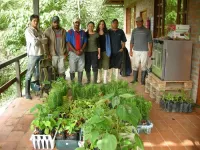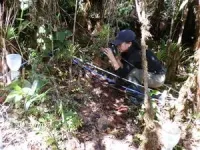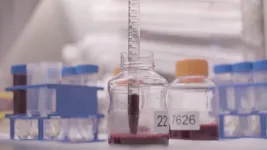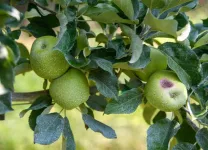Nutrient enrichment: an emerging threat to tropical forests
2025-01-06
(Press-News.org)
Tropical forests, often referred to as the "lungs of the Earth," are essential for sustaining life on our planet. They provide clean air, water, and unparalleled biodiversity. While deforestation due to slash-and-burn agriculture, mining, and logging remains the most recognized threat, less visible but equally dangerous forces are at work. A new study reveals that nutrient enrichment – driven by human activities such as agriculture and fossil fuel combustion – poses a significant risk to the delicate dynamics of tropical forests.
The research, conducted by an international team of scientists from the University of Kaiserlautern-Landau (RPTU), the University of Applied Sciences and Arts Goettingen, and the HUN-REN Centre for Ecological Research in Hungary, focuses on how nutrient deposition affects tropical tree seedlings' growth and biomass accumulation. Their findings, published in Current Forestry Reports, show that this phenomenon can potentially disrupt forest composition and resilience, particularly in the face of global climate change.
By synthesizing data from 59 studies conducted across tropical regions worldwide, the researchers employed meta-analysis to uncover broad patterns of nutrient effects. Their analysis revealed that nutrient addition significantly boosted tree seedling growth, with shoot biomass increasing by an average of 26% and growth rates by 14%. Notably, the combination of nitrogen (N), phosphorus (P), and potassium (K) produced the most pronounced effects, driving growth rate increases of up to 27%. These impacts were particularly pronounced in seasonally dry sites, where growth rates surged by 38% and shoot biomass by an impressive 70%. Lead author Dr. Daisy Cárate Tandalla explains, “NPK are fundamental nutrients for plant growth. However, many tropical soils are nutrient-limited. Adding these nutrients disproportionately benefits fast-growing, competitive species, potentially shifting forest composition.”
Human activities are dramatically altering natural nutrient cycles. While volcanic activity and wildfires have historically contributed to nutrient deposition, agriculture and fossil fuel burning have intensified and expanded this process to even the most remote tropical regions. These nutrient inputs can give a competitive edge to certain tree species, leading to homogenized forests with fewer species – a trend that threatens biodiversity and ecosystem stability. Senior author Dr. Péter Batáry warns, “These changes may reduce species diversity across entire food chains and weaken forest resilience in the face of climate change. The loss of diversity also diminishes the forests' ability to adapt to environmental stressors.”
The study also highlights the complexity of tropical forest research. Co-author Dr. Jürgen Homeier from the University of Applied Sciences and Arts Goettingen notes, “The studies we reviewed used a mix of methods – greenhouse pot experiments, transplantation trials, and in-situ fertilizer applications. Identifying seedlings to the species level remains a significant challenge due to the extraordinary diversity and similarity of young tropical trees.”
The findings underscore the need for urgent attention to nutrient management in tropical regions. While nutrient deposition may seem like a localized issue, its impacts ripple through global ecosystems, affecting biodiversity, carbon storage, and the planet's overall health. Tropical forests are a cornerstone of life on Earth, and preserving their complexity and resilience is crucial. This study is a timely reminder that even remote human activities can have far-reaching consequences for the natural world.
END
ELSE PRESS RELEASES FROM THIS DATE:
2025-01-06
Landfill gas, a mixture of gases produced when garbage breaks down within landfills, contains unwanted traces of siloxane compounds, which are chemical structures containing silicon and oxygen bonds and are found in various products like cosmetics and cleaning agents. These compounds can damage the equipment used to generate energy from landfill gas. In new research published in Environmental Progress & Sustainable Energy, investigators have identified low-cost adsorbents for siloxane removal from landfill gas.
The research highlights the potential of ...
2025-01-06
Weill Cornell Medicine has received a five-year, $2.3 million grant from the Centers for Disease Control and Prevention to improve equitable access to care, quality of life and survival outcomes for young people with all stages of breast cancer.
The grant will enable Weill Cornell Medicine to enhance care coordination for patients and caregivers to optimize support of physical, mental, emotional, social and spiritual needs, while offering culturally relevant resources and targeted interventions. The initiative ...
2025-01-06
BINGHAMTON, N.Y. -- Have you ever noticed a swath of similar business news stories about a particular topic during a Google search, all of them appearing to be reported by different news outlets?
Why might a story on a news site in New York be so similar to one from a site in, for example, Wisconsin? It’s likely because the same media company owns them — and it’s become more commonplace nationwide as news outlets grapple with dwindling resources.
A new study co-authored by Flora Sun, assistant professor of accounting at Binghamton University’s School of Management, ...
2025-01-06
Imagine you’re at a dinner party, but you can’t smell the food cooking or hear the dinner bell. Sounds like a dream, right? What if it wasn’t?
“When we experience the world and interact with people, we use all our senses,” Cold Spring Harbor Laboratory Professor Stephen Shea says. “That’s true for animals and humans.” However, that’s not always the case in developmental disorders like autism. These conditions can affect how the brain processes incoming information, making it difficult to interpret the social cues that drive conversations, dates, and other ...
2025-01-06
2024 was another year of record-breaking temperatures, driving the global water cycle to new climate extremes and contributing to ferocious floods and crippling droughts, a new report led by The Australian National University (ANU) shows.
The 2024 Global Water Monitor Report, involving an international team of researchers and led by ANU Professor Albert van Dijk, found rising temperatures are changing the way water moves around the planet, “wreaking havoc” on the water cycle.
“Rising ...
2025-01-06
COLUMBUS, Ohio – A new study used acoustic sensors that detect the sound of gunfire to show how often children in one Chicago neighborhood are exposed to gunshots while walking to and from school.
Results showed that nearly two-thirds of schools in the Englewood neighborhood of Chicago had at least one gun incident within 400 meters (about one-quarter mile) of where children were walking home during the 2021-22 school year.
These findings suggest a need to redefine federal definitions of school gun violence to include indirect forms of violence that take place near schools, not only on school grounds, in order to more appropriately ...
2025-01-06
Since the 1950s, scientists have used radio waves to uncover the molecular “fingerprints” of unknown materials, aiding in tasks as varied as scanning the human body with MRI machines and detecting explosives at airports.
These methods, however, rely on signals averaged from trillions of atoms, making it impossible to detect tiny variations between individual molecules. Such limitations hinder applications in fields like protein research, where small differences in shape control functionality and can determine the difference between health and disease.
Sub-Atomic Insights
Now, engineers at the University of Pennsylvania ...
2025-01-06
In recent years treatment with powerful biologic and targeted synthetic therapies has changed the landscape for arthritis, but currently finding the right treatment for each person is a matter of trial and error. Only a proportion of patients with inflammatory arthritis respond to each expensive therapy, which results in unnecessary treatment and a long and often frustrating journey for patients, not to mention significant cost to the NHS.
University of Birmingham researchers have just been awarded £3.5 million funding from Johnson & Johnson to investigate ...
2025-01-06
By Rachel Tompa, Ph.D
Your blood is a delicate mixture. Researchers and clinicians often use blood to learn what’s going on inside our bodies, in part because siphoning off a tube of blood is easier and less painful than taking biopsies of an internal organ.
But in some cases, it turns out that blood can be very different outside our bodies. When it comes to certain emerging research techniques, the clock starts ticking as soon as your blood hits the tube. As little as six to eight hours later, some aspects of your blood’s ...
2025-01-06
VANCOUVER, Wash. – Some of the most productive apple regions in America are facing big challenges from a changing climate, according to a Washington State University study.
Researchers analyzed over 40 years of climate conditions that impact the growth cycle of apple trees from bud break and flowering through fruit development, maturation and color development.
While many growing areas are facing increased climate risks, the top three largest apple producing counties in the U.S. were among the most impacted: Yakima in Washington, Kent in Michigan and Wayne ...
LAST 30 PRESS RELEASES:
[Press-News.org] Nutrient enrichment: an emerging threat to tropical forests







